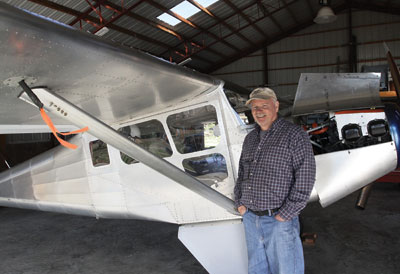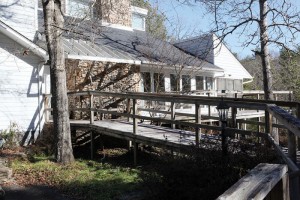 Story by Loyd McIntosh
Story by Loyd McIntosh
Photos by Jerry Martin
There is a funny joke that gets told throughout the aviation community about pilots. It goes a little something like this: What is the difference between a pilot and God? God doesn’t think he’s a pilot.
The meaning of the joke, of course, is that pilots are a different breed, a gonzo blend of Evel Knievel and Steve Austin (The Million-Dollar Man, to all of you born after 1980), willing to cheat the laws of physics, nature and death itself for the ultimate thrill.
To put oneself in the cockpit and spit in the face of gravity certainly takes guts, but what personality traits must it take to build and fly a plane? If Odenville resident Louis “Rusty” Hood is any indication, the answer is a combination of humility, honesty, and decency, with a little spirit of adventure thrown in for good measure.
A retired flight engineer from the Army National Guard, Hood might possibly be one of the nicest and most humble people you’re likely to meet. He just happens to enjoy building and flying experimental aircraft so much that he lives next to his own airstrip. His garage does double duty as a hangar, currently housing a pair of light, propeller-driven airplanes.
The first one is based on a 1930s design and in disrepair at the moment. Hood says he’s looking to part the thing out because “you know, they’ve improved airplane design since the ‘30s, both in construction techniques and design.”
The main attraction in Hood’s garage/hangar is a Murphy Rebel, a small, shiny-silver, two-seater airplane that looks more like a museum exhibit from a bygone era than an actual working plane. However, as Hood explains, this little baby tops out at around 90 miles per hour, can carry about 44 gallons of fuel (good for about six hours of flying), and is a highly popular aircraft in Canada, where it is primarily flown in wooded areas. It’s one of several airplanes Hood has built on his own in almost 40 years of flying.
“It comes in a box, and all the parts are there, and you apply your craftsmanship and 20,000 rivets. Then you add your engine, instruments and your radios, and you got an airplane,” Hood says. “Of course that’s about 10 seconds worth of talk and about two year’s worth of work.”
Somewhat shy and understated, Hood isn’t, by any stretch of the imagination, a gonzo, risk-taker in the air. “I’m no thrill seeker by any means,” says Hood. “I try to be very careful. I’ve been flying both personally and in the military since ‘75, I guess. I don’t take flying lightly.”
 Thirty-plus years of military flying will do that to a guy.
Thirty-plus years of military flying will do that to a guy.
Build them, and they will fly
Hood became interested in planes and flight while working at a motorcycle dealership in the afternoons while in high school. A tinker by nature, Hood first came upon the notion of building his own plane after noticing an ad in the back of Popular Mechanics magazine for a Benson Gyrocopter, a rotorcraft which looks like a cross between a helicopter and a go-cart.
It was in the middle of winter, the slow season at the dealership, so Hood decided to ride his motorcycle to the Benson factory in Raleigh, North Carolina, to look into buying his own gyrocopter. “I just wasn’t impressed, and I did a little research, and I found that most of those plans weren’t viable planes, so I decided against that. But, that did get me started on the idea of building my own plane,” Hood says.
Hood soon realized he didn’t have the funds to purchase his own plane, but began investigating planes he could build on his own. His search led him to an aircraft designed by a Burt Rutan, the experimental aircraft designer famous for designing the Model 86 Voyager, the first plane to fly around the world without stopping or refueling, among other accomplishments.
“He designed a little airplane called Quickie. It was a single-seat all fiberglass, composite, tandem wing. It had a wing out front and a wing in the middle, but no wing on the tail, which is a little unusual,” Hood explains. “If you know anything about Burt Rutan, unusual airplanes are his game.
“They offered the kit for $4,000, and I had $4,000 in my savings exactly, and I bought the kit which consisted of 12 gallons of glue, 144 yards of fiberglass, and two or three boxes of Styrofoam and urethane foam,” Hood adds. “I proceeded to in the course of the next couple of years, construct this airplane, and I flew it for 75 or 100 hours or so.”
Hood joined the Army National Guard in 1974, beginning his military career as a helicopter mechanic and eventually becoming a flight engineer on various military aircrafts, such as Sky Cranes, Huey and some additional fixed-wings. Closing in on his 50th birthday, Hood was deployed to Afghanistan in 2004, spending the next year flying and supervising a maintenance crew of more than 30 soldiers, performing an impressive amount of work while serving his country.
“We flew 7,000 hours, which set a record for our size unit for the time we were there in 04 and 05,” says Hood. “It was a lot of missions and a lot of work to keep those helicopters going. I was the old guy in the bunch at about 50. Most of those guys are teenagers, and they’ve got stamina, and all they need is a little direction.”
Hood retired from the National Guard soon after returning home from Afghanistan, and initially spent his time strictly on land-based activities, primarily motorcycle riding and gardening. It wasn’t long before a friend contacted Hood with a project. He needed help building an airplane – the Murphy Rebel currently sitting in his massive garage.
“I told him I had just gotten back from Afghanistan, and I wasn’t sure I wanted to fly anymore,” Hood says. “I told him to come back and ask me in a year.”
Sure enough, he came back with the intention of enlisting Hood’s help. Not ready to think about taking to the air once again, Hood jumped at the chance, helping complete the build and buying half-ownership of the plane. Eventually, Hood bought the plane outright and is back where he belongs – in the air.
“I’m just a fun flyer. I did enough hazardous flying in the military to get that out of my system,” Hood says. “When the weather is perfect, there’s no wind, and I feel good, I go for a ride.”





















































































